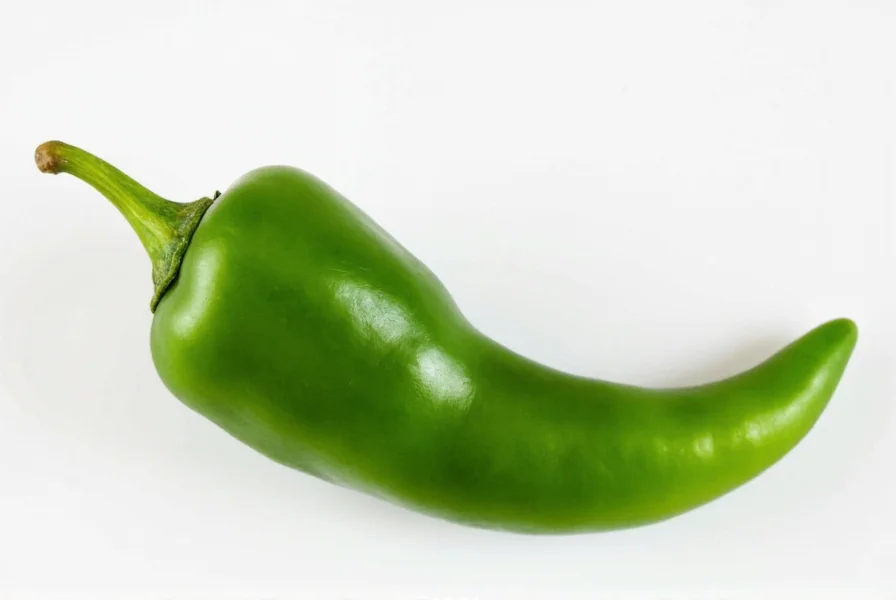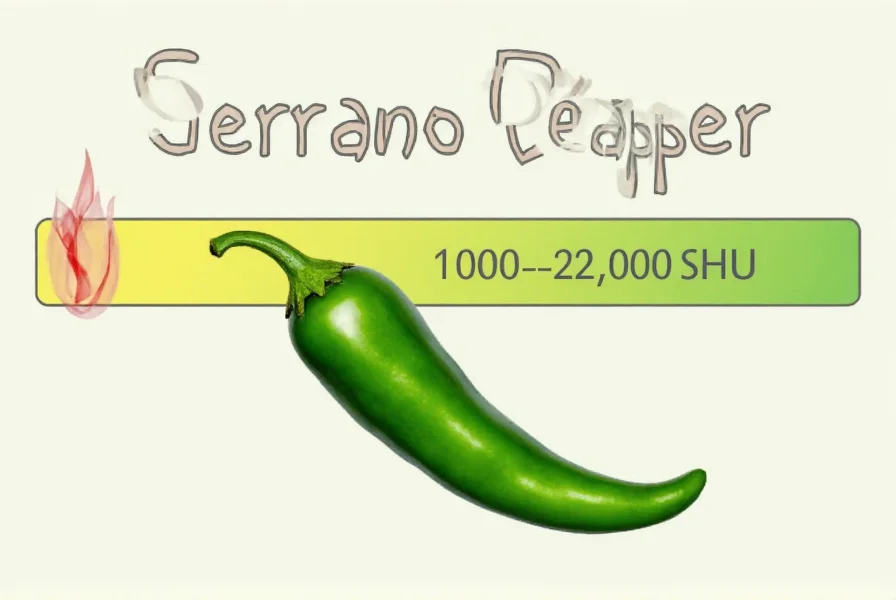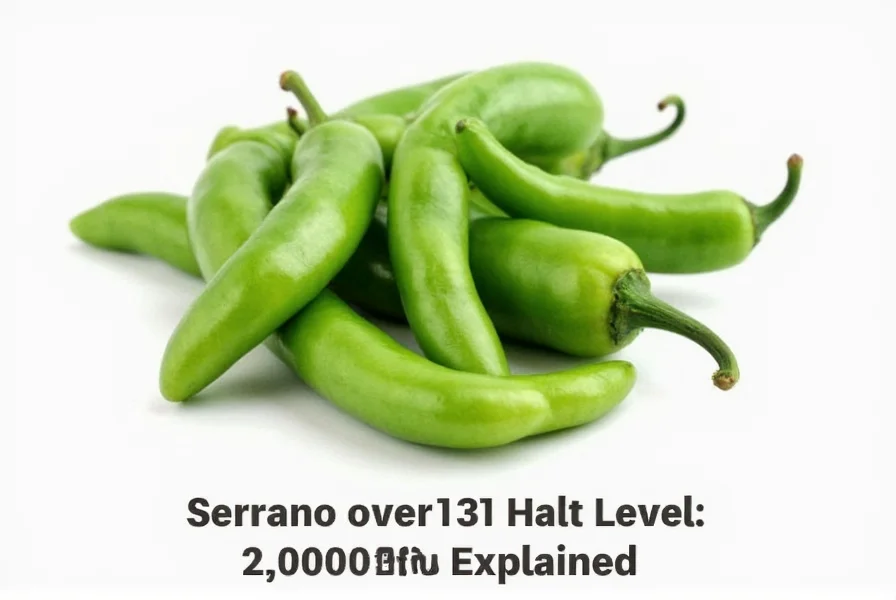Understanding serrano pepper heat is essential for home cooks and culinary enthusiasts who want to use these vibrant chilies without overwhelming their dishes. These slender peppers pack a serious punch that can transform ordinary recipes into exciting flavor experiences when used correctly.
Decoding the Scoville Scale for Serrano Peppers
The Scoville scale measures chili pepper heat by determining capsaicin concentration—the compound responsible for spiciness. Serrano peppers sit firmly in the medium-to-hot range of this scale, delivering a sharp, immediate heat that builds quickly but doesn't linger as long as some hotter varieties.
Developed by pharmacist Wilbur Scoville in 1912, this measurement system originally relied on human tasters diluting pepper extract until the heat became undetectable. Today, high-performance liquid chromatography provides precise capsaicin measurements, converting results to Scoville Heat Units for consumer understanding.
| Pepper Variety | Scoville Heat Units | Heat Relative to Serrano |
|---|---|---|
| Bell Pepper | 0 SHU | 0x |
| Jalapeño | 2,500-8,000 SHU | ⅓ to ½ as hot |
| Serrano | 10,000-23,000 SHU | 1x (baseline) |
| Cayenne | 30,000-50,000 SHU | 1.5-2x hotter |
| Habanero | 100,000-350,000 SHU | 5-15x hotter |
Factors That Influence Serrano Pepper Heat Levels
Serrano heat isn't consistent across all specimens. Several factors dramatically affect their spiciness:
Color and Maturity
Green serranos are harvested earlier and tend to be milder, while red serranos have matured longer on the plant, developing higher capsaicin concentrations. Red serranos can be up to 50% hotter than their green counterparts while offering slightly sweeter flavor notes.
Growing Conditions
Environmental stress increases capsaicin production. Serranos grown in hotter climates with less water typically develop more heat. Commercial growers sometimes intentionally stress plants to produce consistently hotter peppers for specific markets.
Individual Variation
Even on the same plant, serrano peppers can show significant heat variation. The placenta (white ribs inside the pepper) contains the highest concentration of capsaicin, so seeds and inner membranes contribute most to the heat experience.
Practical Handling and Culinary Applications
Working with serrano peppers requires proper technique to manage their heat effectively:
Safe Handling Practices
Always wear gloves when handling serranos, especially when cutting or seeding them. Capsaicin transfers easily to skin and can cause significant irritation, particularly if it contacts eyes or other sensitive areas. After preparation, clean all surfaces and utensils thoroughly with soapy water.
Culinary Substitutions
When substituting serranos in recipes:
- For milder heat: Use 1-2 jalapeños per serrano
- For similar heat profile: Substitute with fresh green Thai chilies
- For hotter version: Replace with half a cayenne pepper
Remember that cooking doesn't eliminate capsaicin—it redistributes throughout the dish. Add serranos gradually, tasting as you go, since their heat intensifies during cooking.
Traditional Uses
In Mexican cuisine, serranos feature prominently in fresh salsas, guacamole, and pico de gallo where their bright heat complements tomatoes and cilantro. They're also excellent for pickling and add distinctive flavor to ceviche. Unlike habaneros, serranos provide noticeable heat without completely dominating other flavors.

When Serranos Might Be Too Hot
While serranos offer versatile heat, they may overwhelm delicate dishes or sensitive palates. Consider these alternatives when milder heat is preferred:
- For fresh applications: Jalapeños provide similar flavor with less intensity
- For cooked dishes: Guajillo peppers offer earthy heat without overwhelming spice
- For finishing touches: A dash of mild chili powder provides color without excessive heat
Understanding your audience's heat tolerance is crucial—what seems moderately spicy to an experienced eater might be uncomfortably hot for others. Always label dishes containing serranos to set proper expectations.

Measuring Heat Perception Accurately
Individual heat tolerance varies significantly due to genetic factors. The TRPV1 receptor sensitivity differs among people, explaining why some handle serranos with ease while others find them overwhelming.
When developing recipes with serranos, consider conducting small taste tests with diverse palates to gauge appropriate heat levels. Remember that fat content (like avocado or dairy) can mitigate perceived heat, while acidic ingredients may intensify the burning sensation.
Frequently Asked Questions
How much hotter are serrano peppers than jalapeños?
Serrano peppers are typically 2-5 times hotter than jalapeños. While jalapeños range from 2,500-8,000 Scoville units, serranos measure 10,000-23,000 SHU. This means even the mildest serrano is hotter than the hottest jalapeño, making direct substitution challenging without adjusting quantities.
Why do some serrano peppers taste hotter than others?
Serrano heat variation comes from multiple factors: maturity (red peppers are hotter than green), growing conditions (drier, hotter climates increase heat), and individual plant genetics. Even on the same plant, peppers exposed to more sun typically develop higher capsaicin levels. The white placental ribs inside contain the most capsaicin, so seeds and membranes significantly impact perceived heat.
Can you reduce the heat of serrano peppers before cooking?
Yes, you can reduce serrano heat by removing the seeds and white membranes where capsaicin concentrates. Soaking sliced peppers in salt water or vinegar for 15-30 minutes can also draw out some capsaicin. For significant heat reduction, blanch serranos in boiling water for 1-2 minutes before use. Remember that cooking redistributes but doesn't eliminate capsaicin, so these methods provide moderate relief rather than complete heat removal.
What's the best way to handle serrano peppers safely?
Always wear disposable gloves when handling serranos, especially when cutting or seeding them. Work in a well-ventilated area to avoid inhaling capsaicin particles. Never touch your face while handling hot peppers. After preparation, clean all surfaces and utensils with soapy water—alcohol-based cleaners work better for stubborn residue. If you get capsaicin on your skin, use milk or oil to break it down rather than water, which spreads the compound.
How do I know if a serrano pepper is particularly hot before using it?
While not foolproof, several visual indicators suggest higher heat: thinner-walled peppers tend to be hotter than thick-walled ones, and peppers with more pronounced striations (white lines) often indicate stress-induced heat production. Red serranos are typically hotter than green ones. The most reliable method is to taste a tiny piece of the inner membrane (after proper hand protection)—start with the smallest amount possible and wait 30 seconds for the heat to register before deciding if the pepper suits your needs.











 浙公网安备
33010002000092号
浙公网安备
33010002000092号 浙B2-20120091-4
浙B2-20120091-4